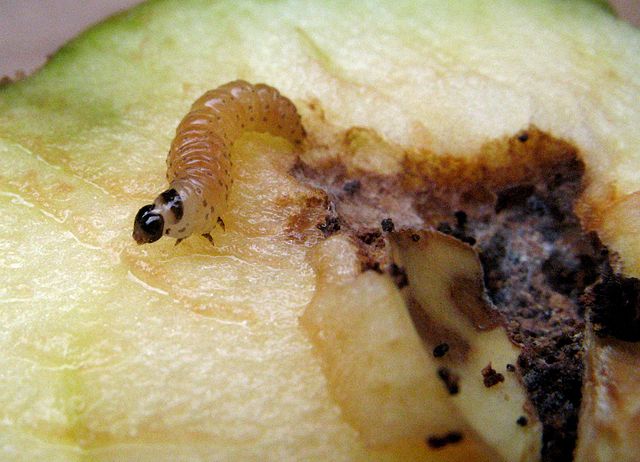You can get nasty surprises when harvesting apples. If the apple is wormy or you bite into a rotten core, a small moth has probably struck, namely the codling moth (Cydia pomonella). The butterflies are 15 to 20 mm in size and inconspicuous brown-bark colored.
Contents
Infestation several times a year
Immediately after mating, a female codling moth lays up to 80 eggs individually on the fruit or leaves. The hatched caterpillars bore into the young fruit and usually penetrate to the core. An infestation can be recognized externally only by the fecal crumbs at the borehole. Four weeks later, the caterpillars leave their food source to pupate. With the help of a silk thread, they reach the trunk and spin themselves into a cocoon behind bark scales.

In warm years, pupation and hatching of the second generation occurs in the same year, with moth flight and subsequent egg laying from the beginning of August. The caterpillars of the second generation now particularly damage the ripening fruit. The result is premature fruit drop and ripe apples with worms.
Using the tricks of nature
- One way is to catch the male moths with pheromone traps. The synthetically produced sex attractant of the females is stored in “dispensers” that are attached to funnel traps. Traps should be hung in the treetops from mid-May to mid-August. One trap per tree is sufficient. Every six weeks they are loaded with a new attractant dispenser.
- A second option is to apply Trichogramma ichneumon flies to the egg clutches. These beneficial insects, only 0.4 mm in size, are egg parasites that lay their own eggs in those of codling moths. The larvae feed on the contents of the host egg during development and pupate inside. About two to three weeks later, a new generation of beneficial insects hatches from the pest eggs. In one growing season, five to eight generations of ichneumon flies can develop in this way. Starting in mid-May, egg-covered cards are applied several times at intervals of three weeks.
- The start of flight, egg laying and hatching of the larvae are highly dependent on the weather. Pheromone traps are used to control codling moth flight activity as important information for ichneumon fly application. As soon as the first moths are found there, the Trichogramma cards are deployed. Just one to two days later, the first animals hatch, with more following over a period of up to 20 days.
Control the winter larvae now
- A third way to control codling moth is now available at the end of September: the winter larvae of codling moth that have spun up on the trunk are treated with predatory nematodes of the species Steinernema feltiae. These natural enemies are tiny nematodes that, through their targeted use, kill 70-90 percent of codling moth larvae, reducing codling moth egg laying by 50-70 percent the following spring. Beginning in late September, nematodes are applied to the trunk by spraying or brushing. Temperatures should not fall below 8 °C for a few hours after treatment. Humid conditions are favorable. The use of the added adhesive facilitates the mobility of the nematodes and improves host finding. Once the nematodes have reached the codling moth larvae, they penetrate them and kill them with the help of a specific bacterium.
- Pheromone traps, ichneumon flies and nematodes are among the weapons of biological crop protection.
Our plant protection expert Dr. Helmut Haardt (re-natur) has been working for years with beneficial insects, the antagonists of pests. Link tip: The Schleswig-Holstein Magazine recently showed a short film about Helmut Haardt’s work and beautiful close-ups of ichneumon flies hatched from mummified aphids.

